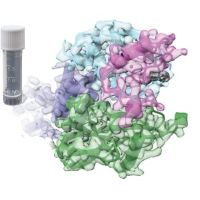Specification
| Description | Recombinant protein from the full-length sequence of homo sapiens ubiquitin D (UBD) (NM_006398). |
| Organism | Homo sapiens (Human) |
| Expression Host | Human Cells |
| Tag Info | His or DYKDDDDK. Please contact us if you need further information or require specific designed tag. |
| Purity | Greater than 90% by SDS-PAGE gel |
| Uniprot ID | O15205 |
| Entry Name | UBD_HUMAN |
| Gene Names | UBD FAT10 |
| Alternative Gene Names | FAT10 |
| Alternative Protein Names | Ubiquitin D (Diubiquitin) (Ubiquitin-like protein FAT10) |
| Application | Antigens, Western, ELISA and other in vitro binding or in vivo functional assays, and protein-protein interaction studies; For research & development use only! |
| Buffer | Purified protein formulated in a sterile solution of PBS buffer, pH7.2, without any preservatives |
| Endotoxin | Endotoxin level is < 0.1 ng/µg of protein (<1EU /µg) |
| Length | 165 |
| Molecular Weight(Da) | 18473 |
| Protein Sequence | (The sequence of expressed protein may have some variation from the sequence shown below. Please contact us for the exact sequence.) MAPNASCLCVHVRSEEWDLMTFDANPYDSVKKIKEHVRSKTKVPVQDQVLLLGSKILKPRRSLSSYGIDKEKTIHLTLKVVKPSDEELPLFLVESGDEAKRHLLQVRRSSSVAQVKAMIETKTGIIPETQIVTCNGKRLEDGKMMADYGIRKGNLLFLACYCIGG |
Background
| Function | FUNCTION: Ubiquitin-like protein modifier which can be covalently attached to target protein and subsequently leads to their degradation by the 26S proteasome, in a NUB1-dependent manner. Probably functions as a survival factor. Conjugation ability activated by UBA6. Promotes the expression of the proteasome subunit beta type-9 (PSMB9/LMP2). Regulates TNF-alpha-induced and LPS-mediated activation of the central mediator of innate immunity NF-kappa-B by promoting TNF-alpha-mediated proteasomal degradation of ubiquitinated-I-kappa-B-alpha. Required for TNF-alpha-induced p65 nuclear translocation in renal tubular epithelial cells (RTECs). May be involved in dendritic cell (DC) maturation, the process by which immature dendritic cells differentiate into fully competent antigen-presenting cells that initiate T-cell responses. Mediates mitotic non-disjunction and chromosome instability, in long-term in vitro culture and cancers, by abbreviating mitotic phase and impairing the kinetochore localization of MAD2L1 during the prometaphase stage of the cell cycle. May be involved in the formation of aggresomes when proteasome is saturated or impaired. Mediates apoptosis in a caspase-dependent manner, especially in renal epithelium and tubular cells during renal diseases such as polycystic kidney disease and Human immunodeficiency virus (HIV)-associated nephropathy (HIVAN). {ECO:0000269|PubMed:15831455, ECO:0000269|PubMed:16495226, ECO:0000269|PubMed:16495380, ECO:0000269|PubMed:17889673, ECO:0000269|PubMed:18574467, ECO:0000269|PubMed:19028597, ECO:0000269|PubMed:19033385, ECO:0000269|PubMed:19166848, ECO:0000269|PubMed:19726511, ECO:0000269|PubMed:19959714}. |
| Pathway | |
| Protein Families | |
| Tissue Specificity | Constitutively expressed in mature dendritic cells and B-cells. Mostly expressed in the reticuloendothelial system (e.g. thymus, spleen), the gastrointestinal system, kidney, lung and prostate gland. {ECO:0000269|PubMed:12730673, ECO:0000269|PubMed:9368598}. |
QC Data
| Note | Please contact us for QC Data |
| Product Image (Reference Only) |  |

